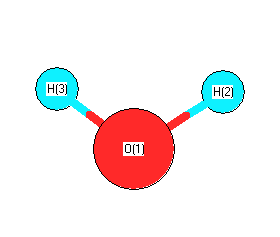Vibrational Frequencies calculated at B2PLYP=FULLultrafine/6-31G**
| Mode Number |
Symmetry |
Frequency
(cm-1) |
Scaled Frequency
(cm-1) |
IR Intensities
(km mol-1) |
Raman Act
(Å4/u) |
Dep P |
Dep U |
|---|
| 1 |
A1 |
3848 |
3848 |
2.65 |
77.59 |
0.17 |
0.28 |
| 2 |
A1 |
1678 |
1678 |
74.31 |
7.50 |
0.54 |
0.70 |
| 3 |
B2 |
3972 |
3972 |
25.50 |
36.80 |
0.75 |
0.86 |
Unscaled Zero Point Vibrational Energy (zpe) 4749.0 cm
-1
Scaled (by 1) Zero Point Vibrational Energy (zpe) 4749.0 cm
-1
See section
III.C.1 List or set vibrational scaling factors
to change the scale factors used here.
See section
III.C.2
Calculate a vibrational scaling factor for a given set of molecules
to determine the least squares best scaling factor.
